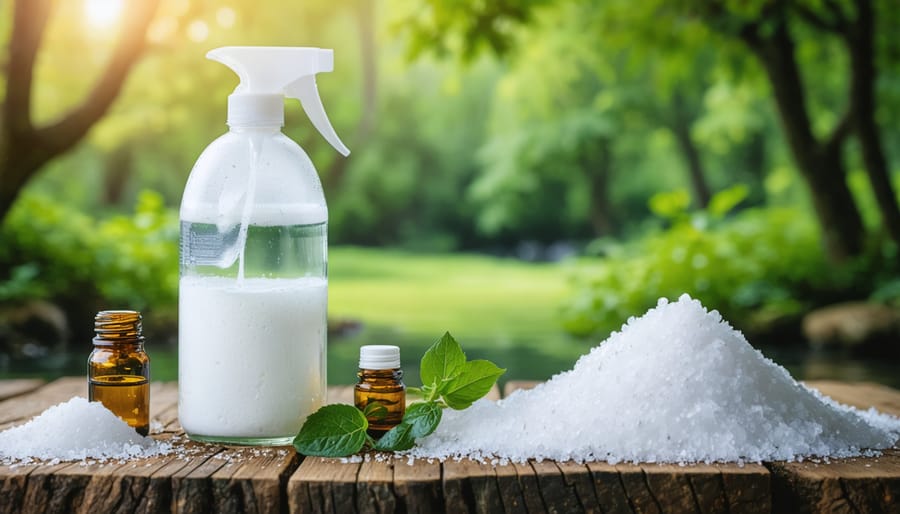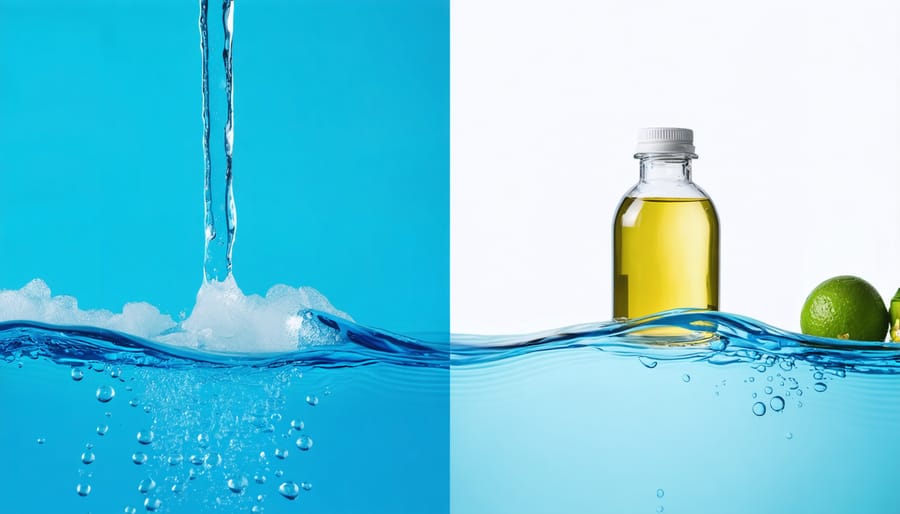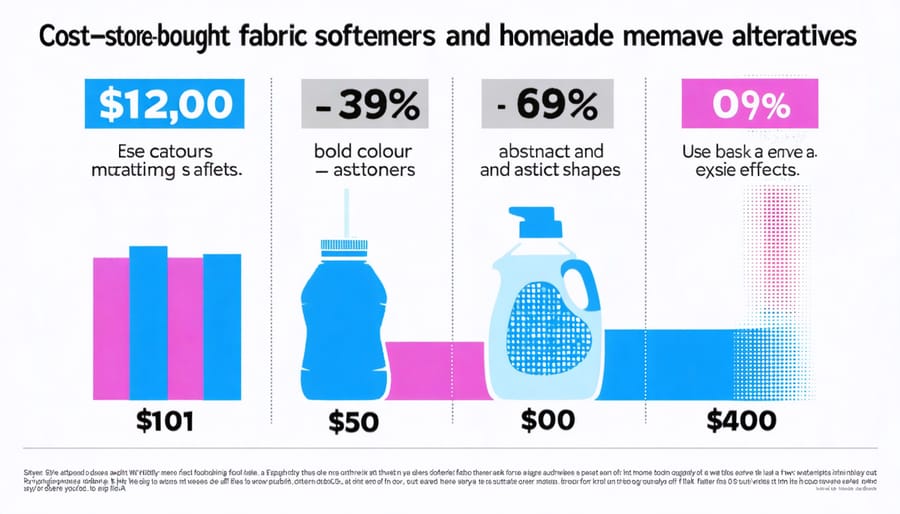
Transform your laundry routine into one of your most impactful sustainable lifestyle choices with natural fabric softener alternatives that protect both your clothes and our planet. White vinegar, essential oils, and baking soda combine to create a powerful, eco-friendly solution that rivals commercial products – without the harsh chemicals or plastic packaging waste. Beyond the environmental benefits, these natural softeners extend fabric life, reduce allergic reactions, and cost significantly less than store-bought options. Whether you’re dealing with delicate sweaters or everyday towels, this gentle yet effective approach delivers that coveted softness while keeping synthetic chemicals out of our waterways. The best part? You likely already have these ingredients in your pantry, making the switch to eco-friendly fabric softening both immediate and effortless.
Why Traditional Fabric Softeners Are Harmful
Environmental Impact
Have you ever wondered what happens to those conventional fabric softeners after they swish down your drain? Let me share something that changed my perspective entirely. Traditional fabric softeners contain chemicals that don’t break down easily in water, creating a lasting impact on our aquatic ecosystems. These synthetic compounds can persist in waterways for years, affecting marine life and potentially entering our food chain.
When I switched to eco-friendly alternatives, I was relieved to learn that natural ingredients like vinegar and essential oils break down completely in water without leaving harmful residues. Many conventional softeners also contain quaternary ammonium compounds (quats) that can contribute to the growth of antibiotic-resistant bacteria in our waterways.
Beyond water pollution, traditional fabric softeners often come in plastic containers that end up in landfills. By choosing eco-friendly options or making your own, you’re not just protecting our water systems – you’re also reducing plastic waste and your overall environmental footprint.

Health Concerns
As someone who struggled with skin sensitivity for years, I understand the concerns many of us have about conventional fabric softeners. These products often contain artificial fragrances and harsh chemicals that can trigger allergic reactions, causing itchy skin, rashes, and even eczema flare-ups. The synthetic ingredients commonly found in traditional softeners, particularly quaternary ammonium compounds, have been linked to respiratory issues and can be especially problematic for those with asthma or chemical sensitivities.
What’s particularly concerning is how these chemicals linger on our clothes, coming into direct contact with our skin throughout the day. Children and those with sensitive skin are particularly vulnerable to these effects. The strong artificial fragrances in conventional softeners can also cause headaches and respiratory irritation for many people. By switching to eco-friendly alternatives, you’re not just helping the environment – you’re also choosing a gentler option for your family’s health and well-being.

Natural Fabric Softening Solutions
Vinegar Solution
White vinegar isn’t just for salad dressing – it’s one of my favorite eco-friendly alternatives for fabric softening! After years of experimenting, I’ve found the perfect ratio: add ½ cup of white vinegar to your washing machine’s fabric softener compartment during the rinse cycle. For smaller loads, you can reduce this to ¼ cup.
Don’t worry about your clothes smelling like vinegar – the scent completely disappears once your laundry dries. If you’re missing that fresh laundry fragrance, try adding 2-3 drops of your favorite essential oil to the vinegar solution. Lavender and lemon are particular favorites among our community members!
Pro tip: Keep a dedicated measuring cup near your washing machine to make the process quick and easy. For delicate fabrics like silk or wool, dilute the vinegar solution with equal parts water before use. I’ve found this method works beautifully on towels too, helping them maintain their absorbency while staying soft and fluffy.
Essential Oil Blends
Creating your own signature scent for laundry is one of the joys of making natural fabric softener! I love experimenting with different essential oil combinations to match the seasons or my mood. For a fresh, clean scent, try 15-20 drops of lavender mixed with 10 drops of lemon essential oil. This combination not only smells amazing but also has natural antibacterial properties.
For a calming bedroom vibe, blend 15 drops of chamomile with 10 drops of vanilla and 5 drops of ylang-ylang. Looking for an energizing morning boost? Mix 15 drops of sweet orange with 10 drops of peppermint and 5 drops of eucalyptus. Just remember to always use high-quality, pure essential oils and start with smaller amounts – you can always add more if needed.
My personal favorite is a cozy blend of 15 drops of cedarwood, 10 drops of bergamot, and 5 drops of sandalwood. It gives my linens a subtle, sophisticated scent that isn’t overwhelming.
Baking Soda Method
Here’s a little secret from my grandmother’s laundry room that never fails to amaze: baking soda is a fantastic natural fabric softener! Simply add half a cup of baking soda to your wash cycle, and you’ll be amazed at how soft your clothes become. The magic happens because baking soda naturally balances the pH levels in your wash water, helping to soften fabrics without leaving any residue.
I particularly love using this method for towels and bedding – it keeps them fluffy without reducing their absorbency. Plus, baking soda is a natural deodorizer, so it helps eliminate any lingering odors in your laundry. As a bonus, it’s incredibly budget-friendly; a single box of baking soda can last for multiple loads.
For extra freshness, try adding a few drops of your favorite essential oil to the baking soda before adding it to your wash. Just remember to give the box a gentle shake before each use to prevent clumping. It’s amazing how something so simple from our kitchen cabinets can be such a powerful laundry ally!
Tips for Best Results
Storage and Shelf Life
Proper storage is key to maintaining the effectiveness of your eco-friendly fabric softener. I learned this the hard way when my first batch of homemade softener went off too quickly! Now, I always store my natural softeners in airtight glass containers or mason jars, keeping them in a cool, dark place away from direct sunlight.
For vinegar-based softeners, you can expect them to last up to 6 months when stored properly. Essential oil blends should be used within 3-4 months to ensure the scents remain vibrant. If you’ve made a citrus-infused softener, it’s best to use it within 2-3 months and always check for any signs of discoloration or unusual odors before use.
Quick tip: Label your containers with the date you made the softener and what’s inside. Trust me, this simple step has saved me from many “what’s in this jar?” moments! If you notice any separation in your mixture, that’s totally normal – just give it a gentle shake before each use.
Remember, natural products don’t contain artificial preservatives, so smaller batches are often better than large ones. This way, you’ll always have fresh, effective softener ready to use.
Common Mistakes to Avoid
I’ve learned from my own DIY journey that even the simplest eco-friendly solutions can sometimes go wrong. Let me share some common pitfalls to help you avoid them. First, don’t skip the vinegar rinse cycle – this step is crucial for removing soap residue and preventing clothes from feeling stiff. Another mistake is using too much essential oil, which can leave spots on your clothes. Start with just a few drops and adjust as needed.
Watch out for using hot water with citrus-based softeners, as the heat can cause the oils to separate. Instead, stick to warm or cold water for best results. Many people also make the mistake of adding their eco-friendly softener at the wrong time – always add it during the final rinse cycle for maximum effectiveness.
If you’re using baking soda in your recipe, avoid mixing it directly with vinegar before adding to your laundry. While both are great ingredients, combining them beforehand neutralizes their softening properties. Finally, remember that natural softeners might feel different from commercial ones at first – give yourself time to adjust to the new texture and feel of your clothes.
Cost Comparison
Making the switch to eco-friendly fabric softeners isn’t just good for the planet – it can also help you save money on household essentials in the long run. Let me break down the numbers for you, based on my own experience and research.
A typical bottle of commercial fabric softener costs around $8-12 and lasts about 2-3 months with regular use. That adds up to roughly $40-60 per year. In contrast, making your own natural fabric softener can cost as little as $15-20 annually. For example, a large container of white vinegar costs about $3-4 and can last several months when used for laundry.
If you prefer the DIY route with essential oils, the initial investment might be higher (around $20-30 for quality oils), but they’ll last for many months. When you break it down per load, commercial softeners cost about $0.25-0.30, while natural alternatives come in at roughly $0.05-0.10 per load.
Here’s what surprised me most: wool dryer balls, though requiring an upfront investment of $15-20, can last for years with proper care. That’s just pennies per load when you consider their lifespan! Plus, they reduce drying time by about 25%, leading to additional savings on your energy bill.
Let’s not forget the hidden costs of conventional fabric softeners – from potential allergic reactions requiring medical attention to the need to replace clothes more frequently due to chemical damage. By choosing gentle, natural alternatives, you’re not just saving money directly – you’re investing in the longevity of your clothes and your family’s well-being.

Making the switch to eco-friendly fabric softeners is more than just a trend – it’s a meaningful step toward a healthier home and planet. By choosing natural alternatives, you’re not only protecting your family from harsh chemicals but also reducing plastic waste and water pollution. I’ve personally noticed that my clothes feel just as soft and fresh using these natural options, and there’s something incredibly satisfying about knowing exactly what’s going into my laundry.
Whether you decide to try the vinegar method, experiment with DIY recipes, or opt for commercially available eco-friendly products, you’re making a choice that benefits both your household and the environment. Remember, every small change adds up to make a big difference. Many members of our community have shared how switching to natural fabric softeners has inspired them to explore other sustainable lifestyle changes.
I encourage you to start small, perhaps with the simple vinegar solution, and gradually explore other natural alternatives that work best for your family. Your clothes – and our planet – will thank you for making this mindful choice. Ready to join the growing community of eco-conscious laundry enthusiasts?



